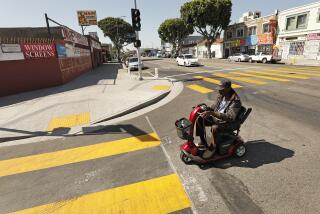Guest writer: L.A. should stop requiring developers to waste space on parking

- Share via
In 1946 — just after World War II, and in an era when the streetcar still ruled the streets — Los Angeles leaders realized they had a problem. People were buying cars, but there wasn’t enough street parking near homes or businesses to store them all. Traffic jams were occurring as drivers cruised around just to find a spot. Officials’ solution seemed simple enough: From then on, every new residential or commercial building would have to be built with space for residents’ or visitors’ cars. This is where our “parking minimums” law originated.
Parking can be a contentious subject. Ask many Angelenos and you’ll hear stories of having to circle the block to find a parking space in their 1920s-era neighborhood where many apartments have no parking built in. Suggest removing parking on a commercial corridor to make room for a bus or bike lane, and the pitchforks can come out.
But then COVID, and our city’s response, happened. Suddenly, restaurants didn’t care about parking — they needed outdoor dining space! Retail stores started using their parking spots for additional space for their wares. And some blocks were transformed into pocket parks or walking corridors to allow more social distancing than was possible on narrow sidewalks. What used to be controversial — reapportioning parking for another use — now seemed obvious. Many of these changes have now become permanent.
Today, parking minimums reign supreme across Los Angeles. Whether or not a developer wants to, they are required to build a minimum number of parking spaces, often based on arbitrary benchmarks. Retail store that sells major appliances? That’s one spot per 500 square feet. Bowling alley? One spot per 100 square feet. Church? One spot per 35 square feet. These requirements cause many developments to take up far more space than they would otherwise need, at a higher cost, contributing to sprawl and traffic. Ironically, many parking spots sit empty much of the time.
AB 2097, a state law passed this year that abolishes all parking minimums near mass transit stops, is a great first step to allow denser development and avoid wasting space. We must do much more.
Parking minimums drive up the cost of construction of housing in Los Angeles — making housing units more expensive than they need to be. A small studio apartment would require one parking spot, meaning a single 400-square-foot studio would actually require more than 715 square feet of total space, even if residents didn’t have cars or want a parking space. A single subterranean parking space can add $35,000 of cost to a building and increase rent by 12.5%; two parking spots can increase rent by 25%.
Without the cost of parking, a developer could make the same investment and build 20% to 33% more units than is possible in the same footprint under the current parking minimums.
Of course, removing parking minimums wouldn’t mean no parking. Developers could still choose to add parking if they wish. But the net effect would be more housing at a lower average cost.
A recent Los Angeles City Council vote cleared the way for a new 15-story office tower in Hollywood. The property is less than a 10-minute walk from two Red Line stations and on a Tier 1 priority bus route on Sunset Boulevard. Yet four of the 15 stories are dedicated to parking — 1,179 spaces, to be exact. We are a region that spends more than $1 billion per mile to build subway lines, and then builds enough parking and highways that driving remains so convenient many wouldn’t think about using the subways.
Los Angeles is in a housing affordability and homelessness crisis. We also happen to be in a climate crisis. We must start building housing like we used to — with little or no parking — to make it more affordable. Remember the charming bungalow courts of the 1920s? And we must start incentivizing usage of our expensive rail and bus investments.
Cars are the single biggest source of greenhouse gas emissions in California. The more we continue to build too many parking places and incentivize driving over all other modes, the worse that problem will get.
Rather than minimum requirements for parking, cities should be enforcing maximum limits for parking spaces per building. The state took action to improve density of development around transit stops. It’s now up to Los Angeles to end parking minimums more broadly, as cities such as San Jose, San Francisco and San Diego have already done. In fact, ending parking minimums helped lead to an affordable housing boom in San Diego.
Where new parking spaces will be built, city planners should ensure that it can later be converted easily to another use.
Sure, our ancestors in Los Angeles drove across town in 20 minutes and parked for free on both ends. That doesn’t make doing so a right now or in the future. We can solve the crises of climate change, homelessness and housing affordability. Conquering our insatiable demand for “enough” parking is a great first step toward all three.
Michael Schneider is the founder of Streets for All.
More to Read
A cure for the common opinion
Get thought-provoking perspectives with our weekly newsletter.
You may occasionally receive promotional content from the Los Angeles Times.










